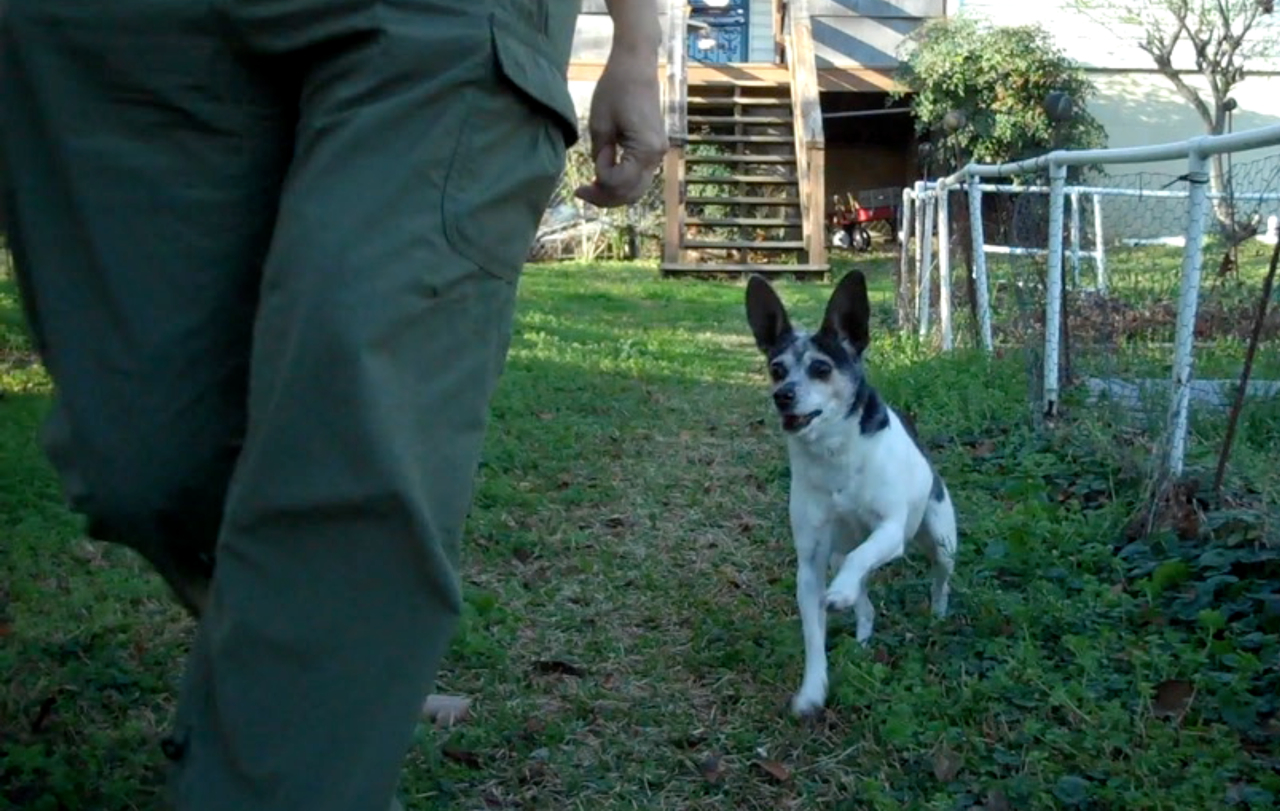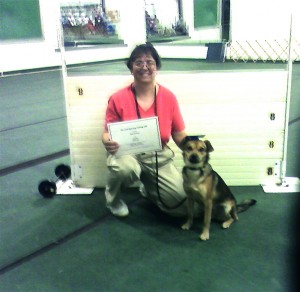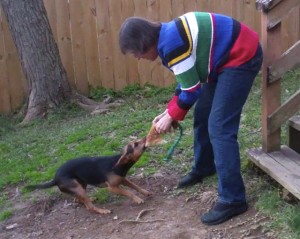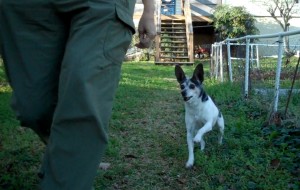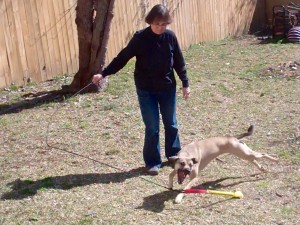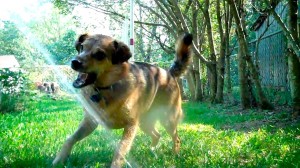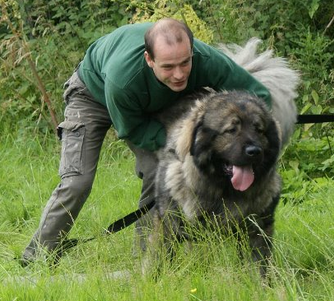I tried hard to start from the beginning as a positive reinforcement trainer, I really did. But my environment, luck, and perhaps my own limitations were against me.
Cricket
When I got my rat terrier Cricket from Ratbone Rescues in 2002, I read up on dog training on the youngish Internet. Back then, the main resources were Usenet newsgroups and a few websites.
I wanted to teach Cricket to walk on a loose leash. Nothing like starting with something easy, right? Not! I read about the “Be a tree” method, where you stop and stand still whenever the dog pulls. I missed the part where you might want to reinforce the dog for the correct behavior, so didn’t use any treats. I wasn’t against that or anything. It just didn’t occur to me. But man, did I ever be a tree. I can tell you all about why that method usually doesn’t work, especially if used by itself!
Every day, literally every day, I took Cricket out for a walk down my street. She would pull ahead; I would stop. She would stand in place BARKING and looking in all four directions. For half a minute, a minute, even two. Eventually she would do something that would loosen the leash, and I would walk again.
My neighbors were entertained by the daily spectacle. There was a whole lot more standing still and barking than there was walking. Don’t ever accuse me of giving up easily. I did this daily for over six months.
At the time I didn’t know enough about reinforcement to understand that Cricket was probably self reinforcing by standing and looking around and barking, and that the loose leash criterion just wasn’t clear enough. But I sure gave the method the college try.
In the end, I gave up and just let her haul me along (all 12 pounds of her). And that was all the training I tried to do for a while. This is hard to admit, but I concluded that she just wasn’t very smart, since she never learned what I thought she should.
Summer
Fast forward to 2006. I still had Cricket but my other dog had passed away. I saw Summer’s picture in an email about dogs that we about to be euthanized in a nearby small town shelter. I went and got her.
She was about 10 months old and under socialized. Not that I knew that at the time. She was also 28 lbs to Cricket’s 12 and they fought. The fights were mostly sound and fury, but scary nonetheless because of the size disparity. Summer was also a big chewer, something I didn’t have much experience with. And she panicked and drooled when crated.
I was in over my head. That was even before I found out that Summer could jump over my four foot chain length fence. I decided it was obvious: I was going to have to train her. Back to the Internet, which had many more resources by now. Again I found positive reinforcement training. I was excited and read up on it a lot. I knew that was what I wanted to do, but I felt like I needed in-person assistance so I started looking for local resources.
The Obedience Club
I found my local dog obedience club, which had a long history as an established organization.
I sent in my papers and counted the days until the session started. I was desperate for help. I was continually wondering if I should re-home Summer.
I went to orientation and saw the dogs do a bunch of competitive obedience behaviors, and even agility. This seemed impressive enough. The teacher whose class I had signed up for brought her dog and a bag of small pieces of roast chicken, showed us a couple of things and told us to bring treats. This was seeming pretty good. She did talk about prong collars and said they would be available to buy, but that they were not mandatory.
I had ended up at a traditional obedience club that was using food on top of corrections. They used pinch collars, choke chains, and even shock collars. I didn’t purchase a pinch collar, not then. I don’t remember whether I performed collar corrections or not in that first class. I do remember thinking that the whole thing about positive reinforcement training must be a myth, since if it worked, wouldn’t people here be doing it exclusively?
Also, it seemed strange that there were all these people who just wanted to train their dogs to be good pets, but the classes were entirely geared towards competitive obedience. In any case, a lot of the folks there really cared about their dogs and I loved being around other “doggie” people. This seemed to be as close to what I was looking for as I was going to get.
I wasn’t finding out how to train Summer not to fight nor jump a fence, but I figured teaching her to be “obedient” would help, and everybody kept telling me so.
We took the beginner obedience class, where we learned the “Show and Tell” method. The teacher would say a “command,” then push the dog into position. With my literal mind, I immediately realized that what she was actually doing was “Tell and Show,” if you had a generous definition of “show.”
I enjoyed the class for the most part. But take a look at our “graduation” picture for Summer’s opinion.
After that we took the next class in line for preparation for competitive obedience. I was supplementing the class methods with techniques from books and the Internet. I don’t remember hurting Summer during the first two classes. (That sounds ominous, doesn’t it?) But I know she came out of it with a big aversion to the Stay behavior as it was taught there, with a stern, loud “Stay” and a hand swinging into her face.
“Leave it” was taught by tempting the dog with food on the floor without first teaching them first what you wanted them to do. Then you were supposed to jerk them away when they went for it. I suppose I did that, although I don’t remember. Perhaps I have blocked it out.
Giving In
What I do remember is finally caving into using a serious aversive in our third class. Summer usually did well when we were training, but whenever we were waiting our turn she was completely detached from me, usually straining at the end of her leash trying to sniff something or see what other dogs were doing. No one had pressured me to use a prong collar. But during that session I kept looking around and seeing everybody else’s dogs standing docilely at their sides, and my Summer completely distracted, at the end of her leash, almost all the time. No one had shared another method of keeping their dog’s attention on them. So I bought a prong collar from the club and fitted it right there. 
I didn’t feel good about it. And I could tell that it was highly uncomfortable, as it was designed to be. I used it only a handful of times.
But I had a turning point in that class. One night one of the teachers stood at a place where we were supposed to turn a corner while heeling with our dog. He planned to wave food at them, and then we were supposed to jerk the leash when they went for the food.
Summer didn’t have the prong collar on (thank goodness) but it was bad enough that I did this exercise. I hated doing it but I did. Once. She went for the food and I jerked. When we went for our second turn, as soon as we neared the man, Summer ducked behind me and wouldn’t come out. It nearly broke my heart. I had been the one to do the leash jerk, but she was afraid of the man (I didn’t know then about how dogs learn by association). She seemed to be hiding behind me. I thought, “Never again.”
Turning Point
That was the beginning of my turning point. Around that time I started taking agility classes and although there was certainly some harsh treatment of dogs from time to time, it was not nearly as common or as harsh in that environment. It’s much harder to do when you don’t have a leash on your dog! And prongs and choke chains were forbidden, not so much as an ethical stance, but the stated reason that they might get caught on the equipment.
Then someone introduced me to an agility teacher who wasn’t affiliated with the club and taught agility and private lessons at her home. I trooped out there with some friends, watched a lesson, and immediately decided to sign up.
Best thing I ever did. Lisa was a CPDT (although at the time I had no idea that there were any credentials for dog trainers) who had been mentored by Bob and Marian Bailey. I also didn’t know the significance of that at all. She traveled several times a year to keep her education up, and was always learning more about teaching dogs and humans both.
The difference between her and my previous teachers was immediately obvious. She was a complete, compassionate advocate for the dog and a brilliant observer. And she understood how learning worked!
“Bottom!”
I can remember a pivotal learning moment. It was about agility contacts. Previously I had been taught to place a little dish or plastic lid with a treat at the end of the contact in hopes that the dog would stop in the right position to eat the treat. Even if this would work consistently, we didn’t do it with nearly enough repetitions, and we didn’t work on fading the lure. We would do it a few times each session while yelling “Bottom” to the dog when she reached the end. Then we could keep yelling “Bottom” every time she reached the end.
I continued the yelling. Finally Lisa asked me, “What does ‘bottom’ mean? Because from what Summer is doing I can’t tell.” Uh. Then she taught me how to teach lovely two on, two off contacts with a board on the ground at home. And I watched it generalize to the equipment! It blew my mind that the end of the contact could be the cue and I didn’t have to yell anything. It worked. I admit I still feel smug when I see people running agility and yelling “Bottom” or “Hit it” or “Target” with that desperate tone. (I don’t mean the people who have successfully trained two contact behaviors and actually need a verbal cue.) My dogs do their contact behavior without a word from me. It was just a question of being shown how to teach it and being willing to practice.
This was one of the steps in my realizing that dogs aren’t born understanding English. It’s amazing to me on what a deep level we somehow come to believe that. We really think that dogs should understand “Sit” and “Down” and “Bottom” just because we are saying it to them. Don’t get me wrong; dogs understand all sorts of things that we don’t even realize. I’m not dissing their intelligence. I’m dissing our lack of common sense.
High Points
There was another event where the world of science based training opened up even more to me. In March 2009 I went to the ORCA conference at the University of North Texas. Wow. I heard Jesus Rosales-Ruiz, Steve Martin, Steve White, Alexandra Kurland, and Kay Laurence speak. It was out of this world wonderful. Not only was it such a high to be finding out that good training was not only humane but incredibly effective, but also that there was this whole huge field of stuff to learn about! Watching movies of lions and tigers and birds! Sitting with 200+ people, all learning about humane, science-based training!
Around that time I had an epiphany. I got it that an animal’s behavior (or a human’s for that matter) is a map of what has been reinforced. This doesn’t seem like a big deal now, but it was a big deal to me then. I realized that there are few behavioral mysteries. If a creature is doing something repeatedly, then it’s because there is something reinforcing that behavior. And that in the case of my dogs, that “something” was usually me, directly or indirectly!
It doesn’t mean we are all little robots. It means that there are ways to observe and quantify the effect of the environment on ourselves and every other creature with a brain stem that we encounter. And that we can use this knowledge for good.
Nowadays this is what my sessions with my dogs look like. Work or play; it’s all the same.
The Future
I often wonder whether I would have been able to cross over completely if I hadn’t found my teacher. I was trying so hard, but for me, it was the in-person, immediate coaching from somebody really knowledgeable that got me over the hump. I do know at least one person who did it on her own (with books and the internet) though, Marge Rogers.
She did not have local help and she made it. I’m sure there are more who did and lots who are teetering like I was!
I want to help. There are still plenty of people in the world without a local humane, science-based trainer to guide them. As a pet owner who doesn’t plan to make the jump to pro trainer, it is my sweet life goal and privilege to offer my perspective and reach out to those people with my writing. You can do it, folks!
Bio

Eileen Anderson is a writer and a serious amateur dog trainer who is in love with dogs and passionately interested in how all species learn. She is an advocate for humane, science-based training and makes videos of what works–and what doesn’t work–in her own dog training. She blogs at eileenanddogs.com.
